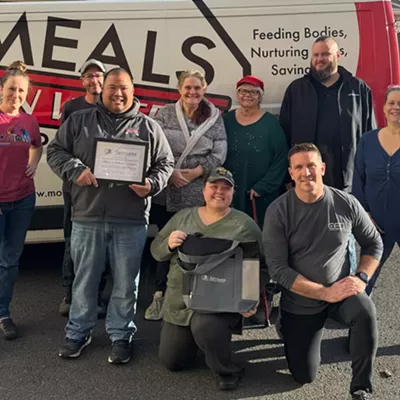The future of American health care is being built from the ground up right off Interstate 90 at the Sullivan exit in Spokane Valley.
If this is surprising, it shouldn’t be. Spokane is the largest health care hub between Seattle and Minneapolis. The metropolitan region recently ranked fourth in the nation for the highest employment numbers and wages in this field.
But it’s not the six hospitals in the city, the 20,000 health care professionals who work here or the new medical school being built downtown that mark the change in how our ailments and illnesses are dealt with, though of course they help.
It’s where the earthmovers and piles of dirt are in the Valley. In the spring of 2014, this location will be a state-of-the-art, $44 million outpatient facility, complete with urgent care, surgical suites and offices for primary care doctors. It’s a 21st century hospital — while not being a hospital at all.
“The world of health care is changing,” says Mike Wilson, CEO of Providence Health Care, which is opening the facility. “We have a strategy and a vision that the care we provide for everyone in the region needs to be close to those people.”
When the facility is up and running, it will have approximately 44 doctors and around 12 nurse practitioners or physician assistants. They’ll see up to 700 patients a day, and the center will have an urgent care facility, imaging services, a laboratory, pharmacy and cancer care services, to name a few. Doctors will also be on hand for primary care and specialty services such as cardiology and oncology.
Perhaps most striking is the facility’s short-stay observation unit, the first of its kind in the Inland Northwest. Instead of spending the night in the hospital for minor surgeries, patients will instead spend their time in this observation unit.
“It really is a matter of the intensity of the care,” says Wilson. “Today we have a number of patients that are observed and discharged within 24 hours. [Even though they’re hospitalized], they are basically patients within the outpatient environment.”
This year alone, Wilson says Providence has seen a 12 percent increase in outpatient surgeries.
Sara Marberry, executive vice president of the Center for Health Design, says the shift can be partly explained by gains in technology.
In an article she wrote for Healthcare Design Magazine, she cited the gains in technology as having a big impact in the next decade. From shortening a three-day hospital stay to a 45-minute in-and-out for invasive surgery, to the “advancement of nanotechnology and more use of telemedicine and home monitoring equipment to observe and treat patients, including ‘do-it-yourself’ diagnostic apps for smart phones/tablets,” Marberry sees technology having a large impact on how we view and use medicine.
But she also says the shift away from hospitals is primarily being driven by the biggest health care legislation in generations, President Barack Obama’s Patient Protection and Affordable Care Act.
“The thing about health care is it’s very slow to change. … Outpatient facilities are certainly where it’s going. Health reform is certainly driving that,” Marberry says. “The train has left the station on health reform. Health organizations started preparing for that no matter who’s in office.”
According to a recent study by the Commonwealth Fund, the United States spends more than any other industrialized nation on health care annually, at about $8,000 per person. Norway and Switzerland, second and third respectively, both spent less than $5,000 per person. Obamacare was meant to combat this inflated difference with its focus on accountability and preventive care.
Wilson, Providence’s CEO, says building a less intensive outpatient facility is about lessening the cost for both provider and patient. “It’s a recognition that we need to provide the right care at the right time in the right place.”
It’s this “right place, right care” philosophy that isn’t being practiced in Washington’s biggest city, according to a recent article in the Seattle Times.
Federal law allows emergency rooms to collect a “bonanza,” says the executive director of Regence Blueshield in the article. ERs aren’t allowed to turn anyone away, but they are allowed to charge more for the services they provide — three to four times the price to treat a broken ankle than at an urgent care facility.
Since health care reform became law in March 2010, Seattle has seen 11 ERs built, renovated or expanded. Critics charge that some hospitals are taking advantage of tax breaks and cash-free bonds to build new ERs in affluent areas, collecting big profits along the way.
Wilson says Providence is taking a different path in Spokane. “We are developing urgent care centers throughout this region that allow people to avoid going to the emergency room,” says Wilson. “We expect to see over 1,500 patients a month,” in the new facility’s urgent care.
Spokane isn’t without its own boom. In the last three years, Providence alone has increased its ranks of physicians from having 45 employed physicians to approximately 275. They’re in the process of adding another 75 by the end of the year.
Much of this came earlier this year when Providence Health Care merged with Group Health, creating the largest physician organization in the region. By the end of the 2013, the two will use the same electronic medical records.
It’s not just Providence that’s growing by leaps and bounds. Community Health Systems, which owns Deaconess and Valley hospitals, bought Rockwood Clinic three years ago.
For Wilson, consolidation is a win-win-win. “It really is a proactive effort to manage the patients in the least intensive environment,” he says. “More convenience, lower cost, better care.”




















